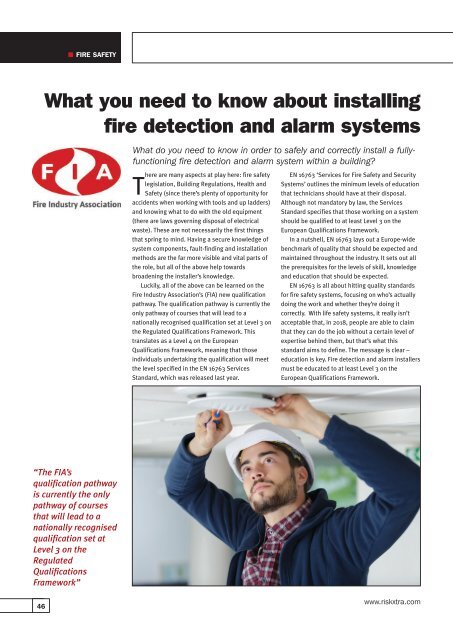PSIJanuary2019
Create successful ePaper yourself
Turn your PDF publications into a flip-book with our unique Google optimized e-Paper software.
FIRE SAFETY<br />
What you need to know about installing<br />
fire detection and alarm systems<br />
What do you need to know in order to safely and correctly install a fullyfunctioning<br />
fire detection and alarm system within a building?<br />
There are many aspects at play here: fire safety<br />
legislation, Building Regulations, Health and<br />
Safety (since there’s plenty of opportunity for<br />
accidents when working with tools and up ladders)<br />
and knowing what to do with the old equipment<br />
(there are laws governing disposal of electrical<br />
waste). These are not necessarily the first things<br />
that spring to mind. Having a secure knowledge of<br />
system components, fault-finding and installation<br />
methods are the far more visible and vital parts of<br />
the role, but all of the above help towards<br />
broadening the installer’s knowledge.<br />
Luckily, all of the above can be learned on the<br />
Fire Industry Association’s (FIA) new qualification<br />
pathway. The qualification pathway is currently the<br />
only pathway of courses that will lead to a<br />
nationally recognised qualification set at Level 3 on<br />
the Regulated Qualifications Framework. This<br />
translates as a Level 4 on the European<br />
Qualifications Framework, meaning that those<br />
individuals undertaking the qualification will meet<br />
the level specified in the EN 16763 Services<br />
Standard, which was released last year.<br />
EN 16763 ‘Services for Fire Safety and Security<br />
Systems’ outlines the minimum levels of education<br />
that technicians should have at their disposal.<br />
Although not mandatory by law, the Services<br />
Standard specifies that those working on a system<br />
should be qualified to at least Level 3 on the<br />
European Qualifications Framework.<br />
In a nutshell, EN 16763 lays out a Europe-wide<br />
benchmark of quality that should be expected and<br />
maintained throughout the industry. It sets out all<br />
the prerequisites for the levels of skill, knowledge<br />
and education that should be expected.<br />
EN 16763 is all about hitting quality standards<br />
for fire safety systems, focusing on who’s actually<br />
doing the work and whether they’re doing it<br />
correctly. With life safety systems, it really isn’t<br />
acceptable that, in 2018, people are able to claim<br />
that they can do the job without a certain level of<br />
expertise behind them, but that’s what this<br />
standard aims to define. The message is clear –<br />
education is key. Fire detection and alarm installers<br />
must be educated to at least Level 3 on the<br />
European Qualifications Framework.<br />
“The FIA’s<br />
qualification pathway<br />
is currently the only<br />
pathway of courses<br />
that will lead to a<br />
nationally recognised<br />
qualification set at<br />
Level 3 on the<br />
Regulated<br />
Qualifications<br />
Framework”<br />
6<br />
www.riskxtra.com

















